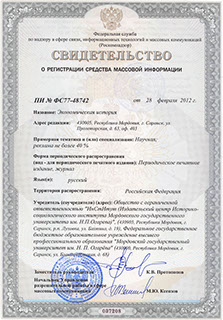Экономическая историЯ
Russian Journal of Economic History
ISSN 2409-630X (Print)
ISSN 2618-916X (Online)
Expert board:
- Scientific Council of RAS on economic history;
- Research and Educational Center «The economic history of Central Russia and the Middle Volga region» of Ogarev Mordovia State University;
- Center of Economic History of Lomonosov Moscow State University
Navigation
Certificate of registration

ISSN 2409-630X (Print), ISSN 2618-916X (Online)
DOI: 10.15507/2409-630X.054.017.202103.249-262
Mikhail V. Mikheev1, Alexander Em. Bedel2
1 The Institute of History and Archaeology, Ural Branch of Russian Scientific Academy (Yekaterinburg, Russia),
e-mail: mikheeviiiauroran@yandex.ru
2 The Institute of History and Archaeology, Ural Branch of Russian Scientific Academy (Yekaterinburg, Russia),
e-mail: bedel54@mail.ru
B. G. Muzrukov and the Problem of Production Organization at the Urals Machine-Building Plant (1946–1953)
Introduction. The purpose of the article is to assess the economic consequences of the transfer in 1947 of the director of the Urals Machine-Building Plant (UZTM) B. G. Muzrukov into the system of the Soviet atomic project for the subsequent development of production at UZTM. B. G. Muzrukov was the main initiator, developer and organizer of the reconversion program carried out at UZTM since 1944. His transfer coincided with the height of its implementation. Materials and Methods. The authors used statistical and clerical materials on the activities of UZTM in 1946–1953. Based on the annual accounting reports of the plant for its main activities, dynamic statistical series of data were compiled on the implementation of the UZTM plan for the shaft and nomenclature of products (method of average percentage). The information obtained was analyzed in the context of the planning targets, personnel changes, and the state of production discipline at the plant. Results and Discussion. It was established that the reassignment of B. G. Muzrukov aggravated the problems associated with the implementation of the production reconversion program at UZTM. They were marked in a number of internal and external factors (drop in reporting rates, conflicts in the workforce, changes in planned buildings, adjustments to the reconversion program by the relevant ministry). Conclusion. The tested/shown method of analysis and evaluation of the results of the UZTM operation can be extended to other industrial enterprises of the USSR in the 1940s–1950s. The subsequent analysis of the data in dynamics and comparison will allow the professional community to expand its own understanding of the specifics of the functioning of the industry in the period of the late Stalinism.
Keywords: B. G. Muzrukov, Ural Heavy Machine Building Plant, Soviet atomic project, First Main Directorate under the Council of Ministers of the USSR, Combine No. 817, command economy, shaft plan, nomenclature plan.
Acknowledgements: The reported study was funded by RFBR, project number 20-09-00103 А “Industrial Urals and the Soviet atomic project: economic and environmental consequences of the functioning of the nuclear-industrial complex in the region (1945–1991)”.
For citation: Mikheev M. V., Bedel A. E. B. G. Muzrukov and the problem of production organization at the Urals Machine-Building Plant (1946–1953). Ekonomicheskaya istoriya = Russian Journal of Economic History. 2021; 17(3): 249–262. (In Russ.). DOI: 10.15507/2409-630X.054.017.202103.249-262.
© Ogarev Mordovia State University. History and Sociology Institute, 2017
68, Of. 411, Bolshevistskaya St., 430005, The editorial office of the scholarly journal «Russian Journal of Economic History»
Tel.: (8342) 24-25-90; 27-07-11, Fax: (8342) 24-25-90, E-mail: jurnal-econom-hist@isi.mrsu.ru
Designed by A. Napalkov, Email: napalkov@isi.mrsu.ru

